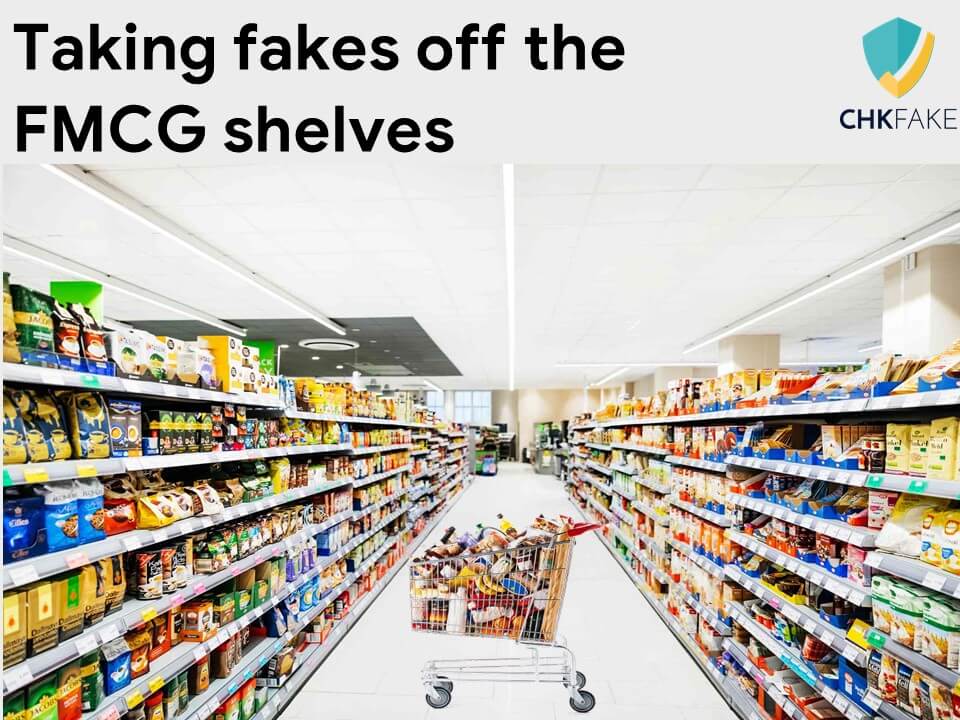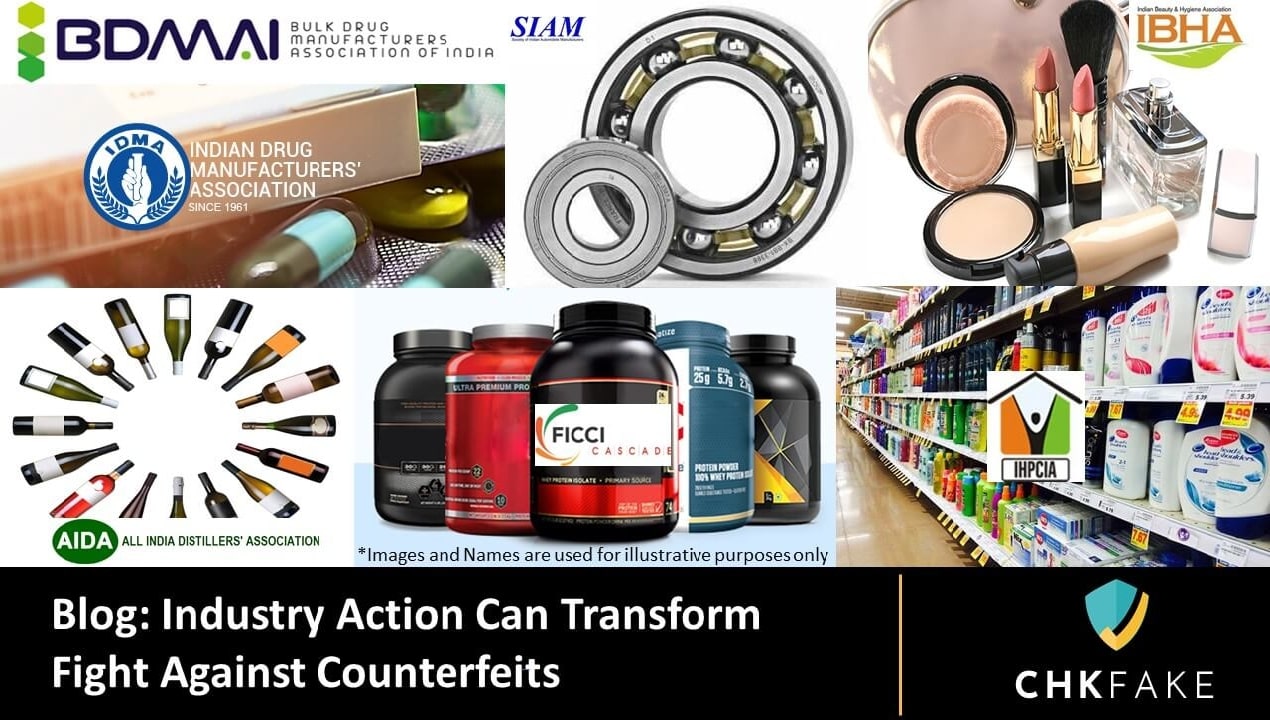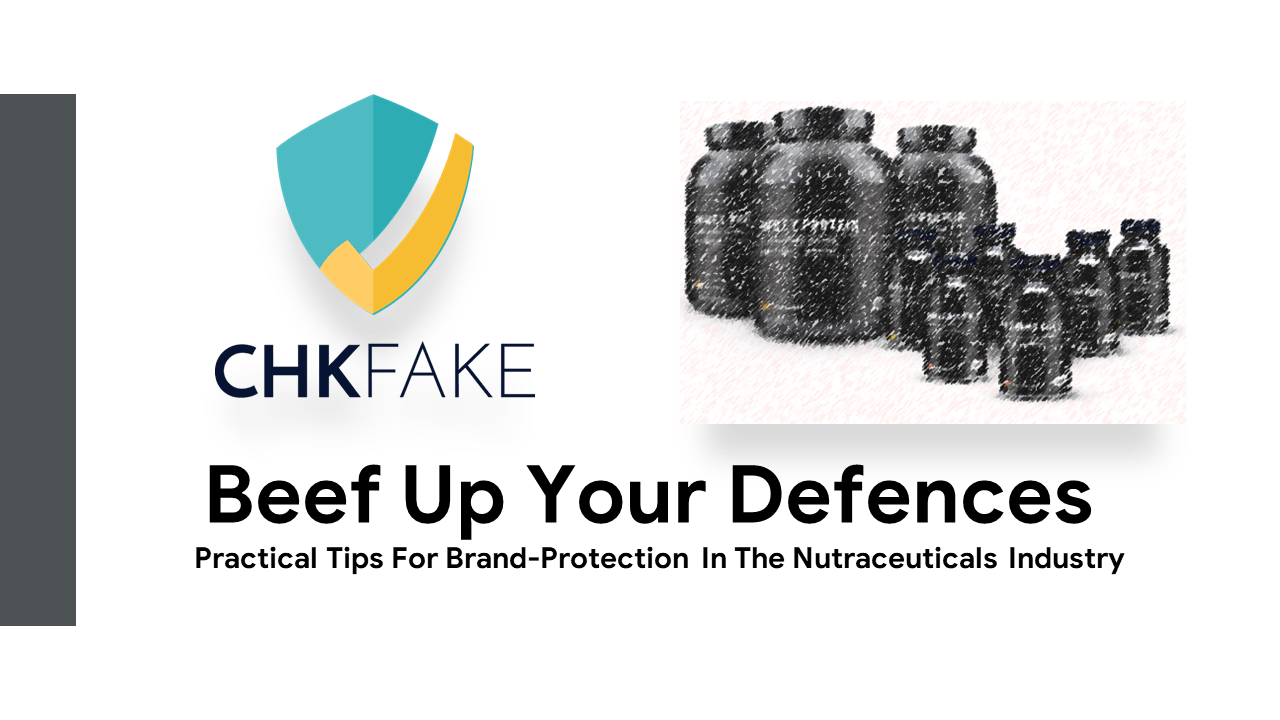This is a 2-part series. Part 1 focuses on the current practices of anti-counterfeiting in the FMCG industry. Part 2 will cover how brand owners can strengthen their anti-counterfeiting program.
Fast Moving Consumer Goods (FMCG – packaged food & beverages, personal goods, and homecare products) remains one of the worst affected industries due to counterfeiting, which accounts for over 26% of business revenues according to a report by FICCI CASCADE. The FMCG counterfeit market is growing at 8% annually.

The current pandemic has created an opportunity for counterfeiters who are taking advantage of impacted supply-chains, curtailed production schedules, and less discerning behaviour from customers to push fake products as genuine at almost the same price points.
Factors driving an increase of fakes/lookalikes in the FMCG industry
There are multiple structural factors which make it easy for counterfeiters in FMCG sector.
A large unorganised sector
Excess capacity in the unorganised sector makes it tempting for these small scale units to easily copy well-known brands and distribute these products to wholesalers and small retailers
Fragmented distribution channel
Given the country’s vast geography, it is more difficult for brands’ own channels to directly reach the small retailers in remote geographies and rural areas. As such, wholesalers are an important point of redistribution and an easy target for fakes and lookalikes as well.
Printing and packaging technology
Easy availability of sophisticated machinery in the printing and packaging industry makes it easy for a counterfeit manufacturer to closely copy reputed brands packaging and labels. The packaging is also easily available from global manufacturing hubs like China.
This access also encourages Lookalikes, which are able to brazenly pass off their brands using similar-sounding names or similar-looking livery as the original brands.
Availability of used packs
The strong recycle culture in India makes it easy for small scale units to buy used packs of reputed brands from trash collectors. These are cleaned up, filled with fake products and redistributed in the market.
High price of branded products
In some cases, high prices of branded products create an opening for fakes and lookalikes to offer supposedly ‘deep discounts’ to deceive and ensnare customers looking for ‘deals’.
Rise of online shopping
The increasing reach of online marketplaces makes it easier for fakes and lookalikes to be listed and sold to unsuspecting consumers. Given that anyone can easily list as a seller on these platforms, and change identity upon being delisted makes it tough to protect consumers against counterfeits.
Unaware or apathetic consumers
Given the low unit price and fast consumption of FMCG products, consumers are not that careful in closely examining what they are buying. This is true particularly in rural areas where awareness and discernment of what is genuine is quite low
Weak regulatory and enforcement mechanism
A generic problem across industries, counterfeits continue to be a low priority for law enforcement although this is now improving as links of counterfeiting to more dangerous criminals in becoming apparent. However, counterfeiting continues to attract relatively light penalties.
The current state of brand protection in the FMCG Industry
Let’s now examine what are the measures that leading FMCG brands are taking to protect themselves against the serious revenue drain and reputation risk that counterfeits presents to them.
1.Use of Anti-counterfeiting technology
Anti-counterfeit technology (ACT) solutions make it difficult for counterfeiters to copy genuine brands’ packaging or refill used packs. But the FMCG industry is plagued by very low adoption rates of ACT solutions. To some extent, this is driven by low unit prices of FMCG products, making it costly for brands to invest in a robust solution for each pack. Even those brands which do use ACT solutions end up choosing them for cost considerations, which run the risk of being easy to copy and difficult to authenticate – such as simple hologram stickers.
The impact of this reality is that 80 per cent of consumers believe that they are using genuine products, as per a FICCI report. That means that a vast majority of consumers can’t differentiate between a genuine and a fake product. Additionally, even brand investigators struggle to quickly and accurately identify counterfeits in the field, thereby blunting the brand’s enforcement efforts.
2.Verification & Customer Education
Brands are wary of widely communicating ”how to verify” information to their customers and value chain. It is difficult anyway if they are not invested in any ACT solution on their product. This makes attempts at customer education vague and non-specific, and inconclusive in identifying fake products.

Fake Identification Tips on a prominent FMCG brand website Even if a brand has invested in an ACT solution, they are wary of communicating it widely as they feel they might be seen as the one with the ‘problem of fakes’.
This is a critical lapse as the entire industry is in the same boat. There is no risk of customer migration since consumers are well aware of this being an industry-wide issue. If all FMCG players collectively commit to invest in strengthening their product security and communicate ‘how to verify genuine products’ to customers, this can significantly reduce the reputation risk and revenue loss due to counterfeits.
3.Enforcement using Third-party Investigators
Enforcement against counterfeiters is the preferred strategy of most FMCG brands. Their focus is on gathering intelligence from the market and conducting raids and seizures against counterfeiters with the support of local law enforcement in conjunction with civil or criminal action.
Many brands hire law firms or investigative agencies directly, who then rely on local investigators or informants to gather evidence against counterfeits. However, there are several challenges that Brands face. Foremost is the materiality of the impact of such a strategy, with limited intelligence available of small stocks of counterfeits being sold, while the main source of supply often escapes notice. In addition, the investigation industry also struggles with a reputation of several bad actors indulging in fraudulent practices. Brands currently lack an efficient lead capture mechanism, and also do not have visibility of enforcement actions conducted on their behalf by third-party investigators.
4. Tackling online counterfeiting
While online counterfeiting is rapidly becoming a substantial threat, most FMCG brands have not started addressing it. Their response is limited to a reactive response to customer complaints. However, most of the times, customers don’t reach that point of discontent to complain, and even when they do, it is to post a review on the online platform. It is imperative for FMCG brands to take the online space more seriously and address this issue strategically. There are experts in this area who can help.
5.Protecting against lookalikes

Image Courtesy: FOEHub
FMCG and Pharma are two industries that are plagued by the presence of look-alike and sound-alike. Lookalikes are often cheaper and fill in the brand’s demand when its supply is scarce. Consumers get deceived by the familiar appearance of the brand’s packaging and don’t have the interest to examine more closely. The problem is more acute in rural areas as many consumers are illiterate and only identify a product by its logo, colour and packaging.
The issue of lookalikes is more addressable since these manufacturers do declare their details on the packaging. Brands can ask them to desist from infringing on their trademarks, provided they have a robust intelligence system that alerts them when these infringements occur.
6.Role of Industry Associations
Industry associations are doing work in the area of education and advocacy. However, the impact is limited as resources of associations are severely constrained to launch a truly widespread and sustained education initiative. Similarly, advocacy efforts with government bodies have limited impact due to the long-term nature of policymaking.
There is an opportunity to use the good offices of industry associations more operationally, in the areas of market intelligence gathering, coordinated enforcement action and product authentication by end customers
7.Illegal Imports
Many FMCG brands face the challenge of goods manufactured in a low tax country or with a lower cost base smuggled illegally without paying prevailing duties. In addition, an ever-present threat is counterfeit packaging imported from manufacturing hubs like China and refilled locally.
The magnitude of the problem is illustrated by the fact that India is now the fourth-largest and the fastest-growing illegal cigarette market in the world with smuggled ones accounting for a quarter of the domestic cigarette industry.
Brands need a robust strategy to tackle smuggled goods. This involves working closely with law enforcement agencies like Customs/ DRI to ensure that their focus is on your products.As is evident, while the counterfeit and look-alike issue is an existential threat to FMCG players, there is an opportunity to do a lot more to protect brands better.
Part 2 of this series will offer a few suggestions which have proven to be very effective in clawing back revenue from counterfeits and protecting brands from future attacks. These are drawn from best practices across industries.
If you liked what you read, please do share in your network. You can follow my articles on LinkedIn and Twitter, or subscribe to My blog.
_________________________________
Tanmay Jaswal is the Founder of Chkfake, a start-up that is disrupting the anti-counterfeiting industry by creating an eco-system of all stakeholders to join the fight against fakes together. The Chkfake mobile app allows users to verify genuineness of any product irrespective of category or brand.
Tanmay has 26 years of global experience in business leadership, marketing and strategy in companies like Coca-Cola and Shell and is an acknowledged authority on brand protection. He has headed the brand protection function for Shell globally and has extensive experience in this space over the last 8 years.






0 Comments